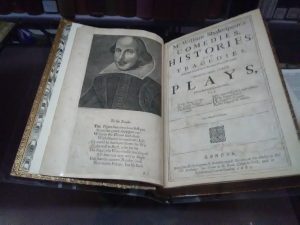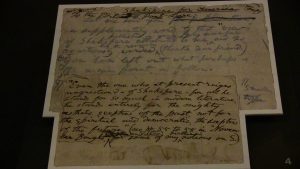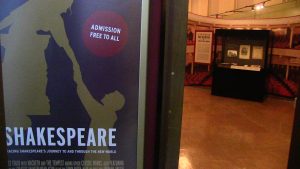 The reputation of Shakespeare deserves more credit than can be given without perspective. The idea that what can be said with style stifles when compared to England’s heroic bard holds true. Genius pokes holes in hubris and casts light while many people struggle with their endeavors in the arts. To further develop the argument that his reputation should be understood is interesting and an important way to come to terms with Shakespeare.
The reputation of Shakespeare deserves more credit than can be given without perspective. The idea that what can be said with style stifles when compared to England’s heroic bard holds true. Genius pokes holes in hubris and casts light while many people struggle with their endeavors in the arts. To further develop the argument that his reputation should be understood is interesting and an important way to come to terms with Shakespeare.
The public library in Downtown Los Angeles has displayed Shakespeare’s reputation through rare books. The collection is stunning and timeless. The perspective is enriching and vast. The brevity of material is centuries old. The books have weathered edges and their appearance is personalized through readership. The few people who have read the books through the centuries have left a few imperfections around the edges, which are interesting considering that the plays are survived by many of the books displayed, including the First Folio.
The later portion of the series focuses on Shakespeare’s reputation with some of American literature’s greatest authors. Ralph Waldo Emerson’s copy of Shakespeare’s plays has been placed centrally among the towering figures showcased. His name is written in the corner of the title page and his obvious admiration is given deferentially. Walt Whitman is similar though his tone is perhaps reflective. Shakespeare’s work does strike the competing author as formidable in comparison and Whitman does appear anxious. His hand written notes can be read with scrutiny:
 “Even the one who at present reigns unquestion’d–of Shakespeare–for all he stands for so much in modern literature, he stands for entirely for the mighty aesthetic sceptres of the past not for the spiritual and democratic, the sceptres of the future […]” Walt Whitman
“Even the one who at present reigns unquestion’d–of Shakespeare–for all he stands for so much in modern literature, he stands for entirely for the mighty aesthetic sceptres of the past not for the spiritual and democratic, the sceptres of the future […]” Walt Whitman
The evolution of England’s literary tradition can be seen at once. The source material for “Othello,” and “Measure for Measure,” along with the source material for Shakespeare’s middle period, the historically based plays, lie side by side with the Fourth Folio. The audience can imagine the author thumbing through the books until inspiration strikes and his full range as a playwright is realized.
 The rare books on display are fascinating and the public library has provided a great service for its patrons. The early portion of the series focuses on the Family of John Wilkes Booth, Edward Dale, an early immigrants who brought the first copy of the Second Folio to America, as well as others. Famous pamphlets can be seen and an early recording of Othello is accessible. The venue was striking from beginning to end and it was an honorable experience to see the First and Fourth Folio which were some of the more exciting books on display.
The rare books on display are fascinating and the public library has provided a great service for its patrons. The early portion of the series focuses on the Family of John Wilkes Booth, Edward Dale, an early immigrants who brought the first copy of the Second Folio to America, as well as others. Famous pamphlets can be seen and an early recording of Othello is accessible. The venue was striking from beginning to end and it was an honorable experience to see the First and Fourth Folio which were some of the more exciting books on display.


257 thoughts on “The First and Fourth Folio on Display, Downtown L.A.”